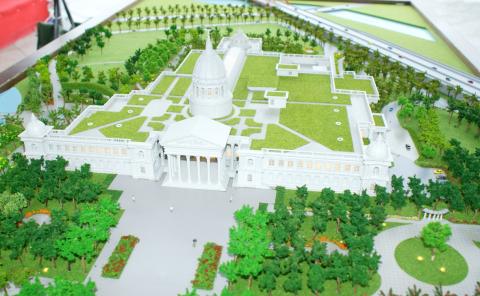|
FEATURE: Chi Mei
Museum collection among the world¡¦s finest: Hsu
By Ling Mei-hsueh and Wu Chun-feng / Staff Reporters

A model of the Chi Mei Museum in
Greater Tainan is on display at the museum in this photo taken on Thursday.
Photo: Wu Chun-feng, Taipei Times
The current Chi Mei Museum, located in Chi
Mei¡¦s headquarters in Greater Tainan, has amassed a rich collection of more than
10,000 objects ¡X specializing in Western paintings and musical instruments ¡X
according to its recent estimate, inviting many art museums in Europe and
talented musicians to borrow from the collection.
Prior to its establishment in 1992, the museum had begun to systematically
assemble a wide ranging collection, including paintings from various periods of
Western art history, musical instruments, worldwide antiques, ecological
specimens and ancient weapons, since the year of 1988.
At present, the number of objects on display at the museum has amounted to
10,783 pieces, according to the latest museum statistics, with the number of
celebrated violins collection exceeding 1,000.
The Chi Mei Cultural Foundation, set up by Chi Mei Corp president Hsu Wen-lung
(³\¤åÀs) in 1977 for the establishment of the museum, boasts a private collection
of at least six Stradivarius violins and several thousand-year-old violins that
were passed down from a well-known Italian violinmaker.
The quantity and quality of the foundation¡¦s violin collection could be
proclaimed among the world¡¦s finest, Hsu said with confidence.
Given the rarity of the items in the museum¡¦s collection, many celebrated
musicians and European art museums have eyed them for loans.
At the end of last year, violinist Su Shien-ta (ĬÅã¹F) borrowed a 1709
Stradivarius violin called the ¡§Viotti Marie Hall¡¨ and a bow used by the
legendary violinist Jascha Heifetz in concerts from the museum.
The Graz salon Orchestra from Austria also borrowed some renowned violins from
the museum during its tour in Taiwan last year.
Aside from loaning out its rare violin collection, the museum has also shipped
some of its original artworks to the Ile Saint-Louis in Paris, France, for a
restoration project in which it assisted the French island in restoring the
sculpture of Theseus Fighting the Centaur Bianor inscribed on the monument of
well-known French sculptor Antoine Louis Barye.
Donation has been one of the primary means for museums to enrich their
collections, with some large-scale contribution of artworks in the past leaving
a mark on history.
The Tate Modern in the UK changed its name from the National Gallery of British
Art primarily due to a generous collection offered by sugar magnate Henry Tate
in 1988. In 2008, London art dealer Anthony d¡¦Offay also donated his collection
of 725 artworks, valued at about NT$7.7 billion (US$256 million), to the
gallery.
In Taiwan, a Taiwanese expatriate in Japan Peng Kai-dong (´^·¢´É), in 2004 donated
his bequests of more than 350 gilt bronze Buddhist sculptures, worth at least
NT$400 million, to the National Palace Museum in the age of 93.
To demonstrate its gratitude at Peng¡¦s generosity, the museum erected a building
hall entitled ¡§Kai-dong Hall¡¨ in his honor.
¡§I am Taiwanese, and the donation is made to my home country rather than to the
National Palace Museum,¡¨ Peng was quoted as saying.
Translated by Stacy Hsu, Staff Writer
|
![]()
![]()
![]()